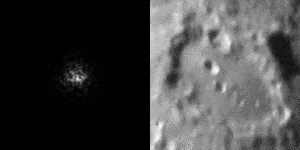Astronomical Seeing

Credit: The Schools' Observatory
Astronomical seeing is why objects in the night sky appear to blur and twinkle. The worse the seeing, the more they blur. It is changes in the Earth's atmosphere. which causes the seeing conditions. The less steady the atmosphere, the worse the seeing becomes.
If the seeing conditions are poor, we do not see as much detail in telescope observations. It is like looking into the sea on a windy day. The more waves in the water, the less you see beneath the surface. If the seeing conditions are good, it's like looking into a flat calm sea. You can clearly see objects in more detail.
A clear night sky may look calm but there can still be movement in the air. There are up-drafts and turbulent layers which affect the light passing through it. These can cause the quality of images to change rapidly. You can see this in the images on this page.
All observatories based on Earth are affected by seeing. We can reduce the negative effects by putting telescopes on the top of high mountains. This means the telescopes can look through less atmosphere. Astronomers have also developed something called adaptive optics technology. This corrects for the effect of seeing.
There is one way to completely remove the effects of seeing. Launch your telescope into orbit above the Earth's atmosphere.

